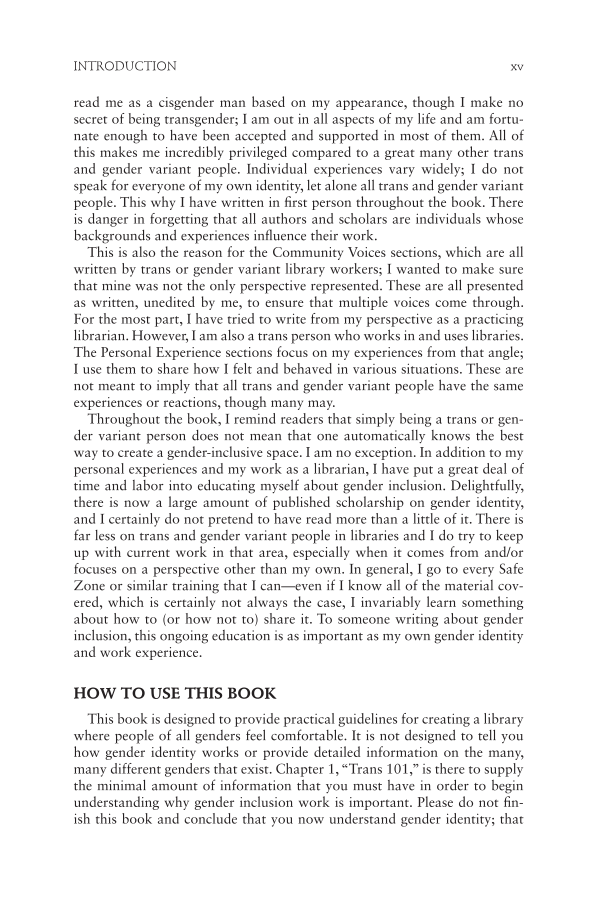Introduction xv read me as a cisgender man based on my appearance, though I make no secret of being transgender I am out in all aspects of my life and am fortu- nate enough to have been accepted and supported in most of them. All of this makes me incredibly privileged compared to a great many other trans and gender variant people. Individual experiences vary widely I do not speak for everyone of my own identity, let alone all trans and gender variant people. This why I have written in first person throughout the book. There is danger in forgetting that all authors and scholars are individuals whose backgrounds and experiences influence their work. This is also the reason for the Community Voices sections, which are all written by trans or gender variant library workers I wanted to make sure that mine was not the only perspective represented. These are all presented as written, unedited by me, to ensure that multiple voices come through. For the most part, I have tried to write from my perspective as a practicing librarian. However, I am also a trans person who works in and uses libraries. The Personal Experience sections focus on my experiences from that angle I use them to share how I felt and behaved in various situations. These are not meant to imply that all trans and gender variant people have the same experiences or reactions, though many may. Throughout the book, I remind readers that simply being a trans or gen- der variant person does not mean that one automatically knows the best way to create a gender-inclusive space. I am no exception. In addition to my personal experiences and my work as a librarian, I have put a great deal of time and labor into educating myself about gender inclusion. Delightfully, there is now a large amount of published scholarship on gender identity, and I certainly do not pretend to have read more than a little of it. There is far less on trans and gender variant people in libraries and I do try to keep up with current work in that area, especially when it comes from and/or focuses on a perspective other than my own. In general, I go to every Safe Zone or similar training that I can—even if I know all of the material cov- ered, which is certainly not always the case, I invariably learn something about how to (or how not to) share it. To someone writing about gender inclusion, this ongoing education is as important as my own gender identity and work experience. HOW TO USE THIS BOOK This book is designed to provide practical guidelines for creating a library where people of all genders feel comfortable. It is not designed to tell you how gender identity works or provide detailed information on the many, many different genders that exist. Chapter 1, “Trans 101,” is there to supply the minimal amount of information that you must have in order to begin understanding why gender inclusion work is important. Please do not fin- ish this book and conclude that you now understand gender identity that
Document Details My Account Print multiple pages
Print
You have printed 0 times in the last 24 hours.
Your print count will reset on at .
You may print 0 more time(s) before then.
You may print a maximum of 0 pages at a time.














































































































































































